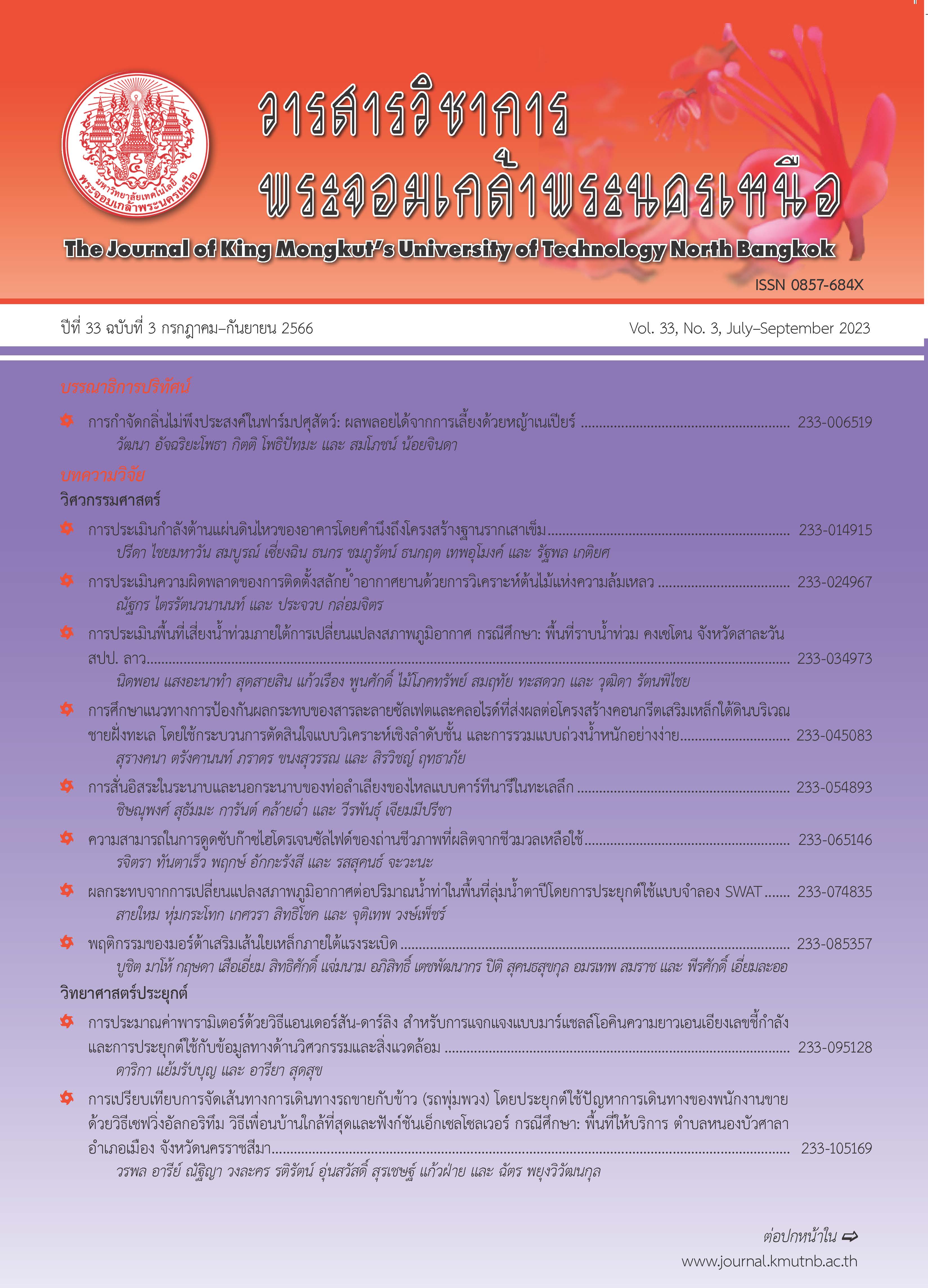ฐานความรู้เพื่อการประเมินการกัดเซาะภายในเขื่อนดินถม
Main Article Content
บทคัดย่อ
บทความนี้รวบรวมองค์ความรู้การไหลซึมที่มีในปัจจุบัน สร้างฐานความรู้ในระดับการคัดกรอง (Screening Level) วินิจฉัยเสมือนเป็นผู้เชี่ยวชาญที่จะบ่งชี้ถึงรูปแบบหรือเส้นทางการไหลซึม โดยเฉพาะกรณีที่เกิดจากการทรุดตัวไม่เท่ากัน และการไหลซึมผ่านในชั้นทราย นำข้อมูลหรือคุณสมบัติพื้นฐานมาจำแนกและจัดประเภท ได้แก่ ข้อมูลฐานราก ข้อมูลกายภาพเขื่อนข้อมูลคุณสมบัติดินฐานราก และข้อมูลความลาดชันระดับน้ำ โดยจัดทำเป็นเกณฑ์ประเมิน 5 ระดับ คือ No Internal Erosion, Very Unlikely, Unlikely, Likely, Very Likely ความถูกต้องของระบบได้ทดสอบและเปรียบเทียบกับเหตุการณ์ที่เกิดขึ้นจริงในอดีตของเขื่อนมรสวบ เขื่อนแม่งัด และเขื่อนมูลบน (ก่อนและหลังปรับปรุงแก้ไข) ซึ่งพบว่า สามารถระบุรูปแบบการพิบัติที่มีความสอดคล้องกับการพิบัติที่ตรวจพบในอดีต อย่างไรก็ตามฐานความรู้นี้เป็นเพียงการระบุกระบวนการความผิดปกติหรือเหตุการณ์ตั้งต้นเท่านั้น การพัฒนาหาความเสี่ยงทั้งหมดต้องให้ครอบคลุมตั้งแต่กระบวนการเริ่มต้นเหตุการณ์ไปสู่การพิบัติ ซึ่งต้องอาศัยการสร้างฐานข้อมูลเขื่อนควบคู่ไปกับการสร้างฐานความรู้ อนาคตควรจัดทำเป็นโปรแกรมหรือระบบผู้เชี่ยวชาญ (Expert System) อย่างเต็มรูปแบบ เพื่อเป็นตัวแทนความรู้ของผู้เชี่ยวชาญถ่ายทอดสู่หน่วยงานต่างๆ ที่เกี่ยวข้อง นำไปใช้งานเพื่อประโยชน์สูงสุดต่อไป
Article Details

อนุญาตภายใต้เงื่อนไข Creative Commons Attribution-NonCommercial-NoDerivatives 4.0 International License.
บทความที่ลงตีพิมพ์เป็นข้อคิดเห็นของผู้เขียนเท่านั้น
ผู้เขียนจะต้องเป็นผู้รับผิดชอบต่อผลทางกฎหมายใดๆ ที่อาจเกิดขึ้นจากบทความนั้น
เอกสารอ้างอิง
Engineering News-Record, “Failure of dam in Wales due to washout under foundation,” vol. 96, no 1, pp. 12–13, January 1926.
USCOLD, “Lessons from Dam Incidents,” ASCE, New York, 1975.
S. Soralump and W. Mairaing, “Failure of dam,” presented at Failure of Dam safety training project, Bangkok, Sep. 20-21, 2007 (in Thai).
RID, “Report of visual inspection and soil mechanics analysis of seepage area on MUNBON dam,” Royal Irrigation Department, Dusit District, Bangkok, 1975 (in Thai).
Kasetsart University, “Remediation and improving of MUNBON dam project,” Royal Irrigation Department, Dusit District, Bangkok, 1997 (in Thai).
GERD, “Analysis report and remediation of morasuab dam project,” Geotechnical Engineering Research and Development Center, Kasetsart University, Bang Khen District, Bangkok, 2017 (in Thai).
R. Fell, M. Foster, J. Cyganiewicz, G. Sills, N. Vroman, and R. Davidson. (2009, April). Risk Analysis for Dam Safety: A Unified Method for Estimating Probabilities of Failure of Embankment Dams by Internal erosion and Piping. The university of new south wales, Australia. [Online]. Available: http://www.civeng.unsw.edu.au
ICOLD. (2017, February). Bulletin 164 Internal Erosion of Existing Dams, Levees and Dikes, and their Foundations. International Commission on Large Dams. Paris. [Online]. Available: http:// www.icold-cigb.org.
FERC. (2016, November). Risk Informed Decision Making. Federal Energy Regulatory Commission, France. [Online]. Available: http://www.FonCSI. org.
C. Curt, L. Peyras, D. Boissier, “A knowledge formalisation and integration-based method for the assessment of dam performance,” Computer-aided Civil and Infrastructure Engineering, vol. 25, no. 3, pp. 171–183, 2008
C. Curt, A. Talonม and G. Mauris “Using physical measurements, sensory evaluations and expert judgments in a dam assessment support system,” in Proceedings 2th Imeko Joint Symposium on Man Science & Measurement, 2011, pp. 239–245.
B. M. Franck and T. Krauthammer, “An expert system for field inspection of concrete dams,” Engineering with Computers, vol. 5, pp. 23–38, 2008.
C. Song-An, C. Cheng-Chung, T. J. WANG, and C. Kuo-Ching, “A knowledge-based system for dam safety assessment in Taiwan,” in Proceedings 2nd Worldwide ECCE Symposium on ICT in the Practice of Building and Civil Engineering, 2001.
M. E. Emiroglu, A. Tuna, and A. Arslan, “Development of an expert system for selection of dam type on alluvium foundations,” Engineering with Computers, vol. 18, no. 1, pp. 24–37, 2002.
Z. Wen, Z. Wu, and H. Su, “Safety monitoring system of dam based on bionics Computer Science,” in Proceedings of 2004 International Conference on Machine Learning and Cybernetics, 2004.
H. Su, Z. Wen, and Z. Wu, “Study on an intelligent inference engine in Early-warning system of dam health,” Water Resources Management, vol. 25, no. 6, pp. 1545–1563, 2011.
C. Curt and R. Gervais. “Approach to improving the quality of data used to analyse dams Illustrations by two methods,” Journal of Environmental and Civil Engineering, vol. 18, no. 1, pp. 87–105, 2014.
M. L. Filho, Diego A. F. Balbi, A. E. Toscano, P. S. F. Barbosa, R. M. Salgado, Luiz F. V. Vianna, and M. N. Barreto, “Expert system for dam assessment and emergency detection,” presented at the 6th International conference on flood management, Brazil, September 2014.
W. Mairiang, “Dam safety and maintenance by using Condition Indexing of training project,” Kasetsart University, Bang Khen District, Bangkok, 2007 (in Thai).
GERD, “Completion report of the safety criteria for geotechnical instruments on the internal erosion in embankment dams,” Geotechnical Engineering Research and Development Center, Bang Khen District, Bangkok, 2007 (in Thai).
D. Wattanadilokkul, “EGAT’s current dam safety development,” presented at Electricity Generating Authority of Thailand, Bangkok, 2016 (in Thai).
M. Maniam, “Critical seepage gradients beneath embankment dams,” M.S. thesis, Department of Civil Engineering, School of Civil and Environmental Engineering. The University of New South Wales, Sydney, New South Wales 2004.
C. F. Wan and R. Fell, “Investigation of rate of erosion of soils in embankment dams,” Journal of Geotechnical and Geoenvironmental Engineering, vol. 13, no. 4, pp. 373–380, 2004.
C. Wan and R. Fell, “Laboratory tests on the rate of piping erosion of soils in embankment dams,” Geotechnical Testing Journal, vol. 27, no. 3, pp. 295–303, 2004.
L. M. Zhang, “Effects of abutment slopes on the performance of high rockfill dams,” Canadian Geotechnical Journal, vol. 35, no. 5, pp. 489–497, 2011.
J. L. Sherard, R. J. Woodward, S. F. Gizienski, and W. A. Clevenger, Earth and Earth Rock Dams: Engineering Problems of Design and Construction, 1st ed., John Wiley and Sons, 1963.
J. L. Sherard, Embankment Dam Cracking. Embankment-Dam Engineering, 1st ed., John Wiley and Sons, 1973, pp. 271–353.
Y. A. H. Dallo, “Discussion of Influence of particle-size distribution homogeneity on shearing of soils subjected to internal erosion,” Canadian Geotechnical Journal, vol. 57, no. 11, 2021.
S. Li and David M. Wood, “Influence of particle-size distribution homogeneity on shearing of soils subjected to internal erosion” Canadian Geotechnical Journal, vol. 57, no. 1, pp. 1684–1694, 2020.
Theoretical Soil Mechanics in Engineering Practice, 3rd ed., Wiley, 1948.
H. Rönnqvist and P. Viklander, “On the Kenneylau approach to internal stability evaluation of soils,” Geomaterials Journal, vol. 4, no. 4, pp. 129–140, 2014.
C. F. Wan and R. Fell, “Assessing the potential of internal instability and suffusion in embankment dams and their foundations,” Journal of Geotechnical and Geoenvironmental Engineering, vol. 134, no. 3, pp. 401–407, 2008.
J. H. Schmertmann, “The non-filter factor of safety against piping through sands,” in Geo-Congress 1998, Boston, 1998.
GERD, “Final Report of Safety Criteria for Geotechnical Instruments on Mae Ngud Dams,” Geotechnical Engineering Research and Development Center, Bang Khen District, Bangkok, 2020 (in Thai).

